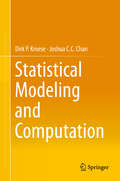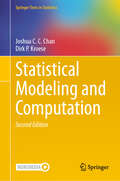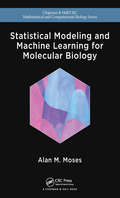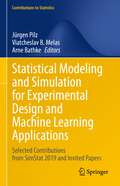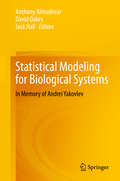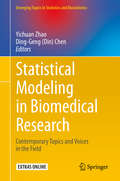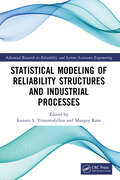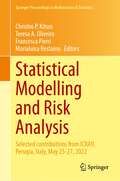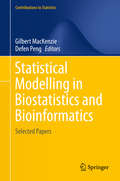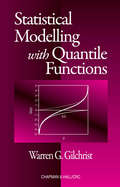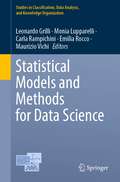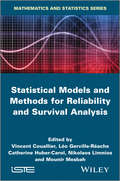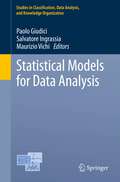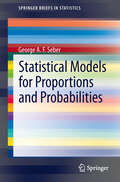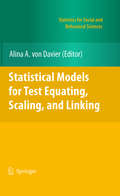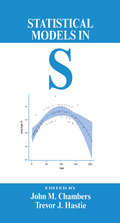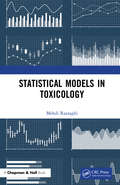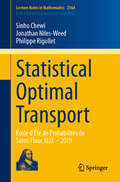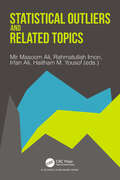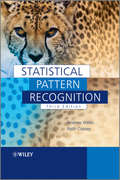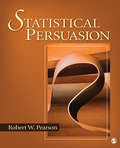- Table View
- List View
Statistical Modeling and Computation
by Dirk P. Kroese Joshua C.C. ChanThis textbook on statistical modeling and statistical inference will assist advanced undergraduate and graduate students. Statistical Modeling and Computation provides a unique introduction to modern Statistics from both classical and Bayesian perspectives. It also offers an integrated treatment of Mathematical Statistics and modern statistical computation, emphasizing statistical modeling, computational techniques, and applications. Each of the three parts will cover topics essential to university courses. Part I covers the fundamentals of probability theory. In Part II, the authors introduce a wide variety of classical models that include, among others, linear regression and ANOVA models. In Part III, the authors address the statistical analysis and computation of various advanced models, such as generalized linear, state-space and Gaussian models. Particular attention is paid to fast Monte Carlo techniques for Bayesian inference on these models. Throughout the book the authors include a large number of illustrative examples and solved problems. The book also features a section with solutions, an appendix that serves as a MATLAB primer, and a mathematical supplement.
Statistical Modeling and Computation (Springer Texts in Statistics)
by Dirk P. Kroese Joshua C. ChanThis book, Statistical Modeling and Computation, provides a unique introduction to modern statistics from both classical and Bayesian perspectives. It also offers an integrated treatment of mathematical statistics and modern statistical computation, emphasizing statistical modeling, computational techniques, and applications. The 2nd edition changes the programming language used in the text from MATLAB to Julia. For all examples with computing components, the authors provide data sets and their own Julia codes. The new edition features numerous full color graphics to illustrate the concepts discussed in the text, and adds three entirely new chapters on a variety of popular topics, including: Regularization and the Lasso regression Bayesian shrinkage methods Nonparametric statistical tests Splines and the Gaussian process regression Joshua C. C. Chan is Professor of Economics, and holds the endowed Olson Chair at Purdue University. He is an elected fellow at the International Association for Applied Econometrics and served as Chair for the Economics, Finance and Business Section of the International Society for Bayesian Analysis from 2020-2022. His research focuses on building new high-dimensional time-series models and developing efficient estimation methods for these models. He has published over 50 papers in peer-reviewed journals, including some top-field journals such as Journal of Econometrics, Journal of the American Statistical Association and Journal of Business and Economic Statistics. Dirk Kroese is Professor of Mathematics and Statistics at the University of Queensland. He is known for his significant contributions to the fields of applied probability, mathematical statistics, machine learning, and Monte Carlo methods. He has published over 140 articles and 7 books. He is a pioneer of the well-known Cross-Entropy (CE) method, which is being used around the world to help solve difficult estimation and optimization problems in science, engineering, and finance. In addition to his scholarly contributions, Dirk Kroese is recognized for his role as an educator and mentor, having supervised and inspired numerous students and researchers.
Statistical Modeling and Machine Learning for Molecular Biology (Chapman & Hall/CRC Computational Biology Series)
by Alan MosesMolecular biologists are performing increasingly large and complicated experiments, but often have little background in data analysis. The book is devoted to teaching the statistical and computational techniques molecular biologists need to analyze their data. It explains the big-picture concepts in data analysis using a wide variety of real-world molecular biological examples such as eQTLs, ortholog identification, motif finding, inference of population structure, protein fold prediction and many more. The book takes a pragmatic approach, focusing on techniques that are based on elegant mathematics yet are the simplest to explain to scientists with little background in computers and statistics.
Statistical Modeling and Simulation for Experimental Design and Machine Learning Applications: Selected Contributions from SimStat 2019 and Invited Papers (Contributions to Statistics)
by Jürgen Pilz Viatcheslav B. Melas Arne BathkeThis volume presents a selection of articles on statistical modeling and simulation, with a focus on different aspects of statistical estimation and testing problems, the design of experiments, reliability and queueing theory, inventory analysis, and the interplay between statistical inference, machine learning methods and related applications. The refereed contributions originate from the 10th International Workshop on Simulation and Statistics, SimStat 2019, which was held in Salzburg, Austria, September 2–6, 2019, and were either presented at the conference or developed afterwards, relating closely to the topics of the workshop. The book is intended for statisticians and Ph.D. students who seek current developments and applications in the field.
Statistical Modeling for Biological Systems: In Memory of Andrei Yakovlev
by David Oakes Anthony Almudevar Jack HallThis book commemorates the scientific contributions of distinguished statistician, Andrei Yakovlev. It reflects upon Dr. Yakovlev’s many research interests including stochastic modeling and the analysis of micro-array data, and throughout the book it emphasizes applications of the theory in biology, medicine and public health. The contributions to this volume are divided into two parts. Part A consists of original research articles, which can be roughly grouped into four thematic areas: (i) branching processes, especially as models for cell kinetics, (ii) multiple testing issues as they arise in the analysis of biologic data, (iii) applications of mathematical models and of new inferential techniques in epidemiology, and (iv) contributions to statistical methodology, with an emphasis on the modeling and analysis of survival time data. Part B consists of methodological research reported as a short communication, ending with some personal reflections on research fields associated with Andrei and on his approach to science. The Appendix contains an abbreviated vitae and a list of Andrei’s publications, complete as far as we know. The contributions in this book are written by Dr. Yakovlev’s collaborators and notable statisticians including former presidents of the Institute of Mathematical Statistics and of the Statistics Section of the AAAS. Dr. Yakovlev’s research appeared in four books and almost 200 scientific papers, in mathematics, statistics, biomathematics and biology journals. Ultimately this book offers a tribute to Dr. Yakovlev’s work and recognizes the legacy of his contributions in the biostatistics community.
Statistical Modeling in Biomedical Research: Contemporary Topics and Voices in the Field (Emerging Topics in Statistics and Biostatistics)
by Ding-Geng Din Chen Yichuan ZhaoThis edited collection discusses the emerging topics in statistical modeling for biomedical research. Leading experts in the frontiers of biostatistics and biomedical research discuss the statistical procedures, useful methods, and their novel applications in biostatistics research. Interdisciplinary in scope, the volume as a whole reflects the latest advances in statistical modeling in biomedical research, identifies impactful new directions, and seeks to drive the field forward. It also fosters the interaction of scholars in the arena, offering great opportunities to stimulate further collaborations. This book will appeal to industry data scientists and statisticians, researchers, and graduate students in biostatistics and biomedical science. It covers topics in:Next generation sequence data analysisDeep learning, precision medicine, and their applicationsLarge scale data analysis and its applicationsBiomedical research and modelingSurvival analysis with complex data structure and its applications.
Statistical Modeling of Reliability Structures and Industrial Processes (ISSN)
by Mangey Ram Ioannis S. TriantafyllouThis reference text introduces advanced topics in the field of reliability engineering, introduces statistical modeling techniques, and probabilistic methods for diverse applications.It comprehensively covers important topics including consecutive-type reliability systems, coherent structures, multi-scale statistical modeling, the performance of reliability structures, big data analytics, prognostics, and health management. It covers real-life applications including optimization of telecommunication networks, complex infrared detecting systems, oil pipeline systems, and vacuum systems in accelerators or spacecraft relay stations. The text will serve as an ideal reference book for graduate students and academic researchers in the fields of industrial engineering, manufacturing science, mathematics, and statistics.
Statistical Modelling and Risk Analysis: Selected contributions from ICRA9, Perugia, Italy, May 25-27, 2022 (Springer Proceedings in Mathematics & Statistics #430)
by Christos P. Kitsos Teresa A. Oliveira Francesca Pierri Marialuisa RestainoThis volume covers the latest results on novel methods in Risk Analysis and assessment, with applications in Biostatistics (which is providing food for thought since the first ICRAs, covering traditional areas of RA, until now), Engineering Reliability, the Environmental Sciences and Economics. The contributions, based on lectures given at the 9th International Conference on Risk Analysis (ICRA 9), at Perugia, Italy, May 2022, detail a wide variety of daily risks, building on ideas presented at previous ICRA conferences. Working within a strong theoretical framework, supporting applications, the material describes a modern extension of the traditional research of the 1980s. This book is intended for graduate students in Mathematics, Statistics, Biology, Toxicology, Medicine, Management, and Economics, as well as quantitative researchers in Risk Analysis.
Statistical Modelling by Exponential Families (Institute of Mathematical Statistics Textbooks #12)
by Rolf SundbergThis book is a readable, digestible introduction to exponential families, encompassing statistical models based on the most useful distributions in statistical theory, including the normal, gamma, binomial, Poisson, and negative binomial. Strongly motivated by applications, it presents the essential theory and then demonstrates the theory's practical potential by connecting it with developments in areas like item response analysis, social network models, conditional independence and latent variable structures, and point process models. Extensions to incomplete data models and generalized linear models are also included. In addition, the author gives a concise account of the philosophy of Per Martin-Löf in order to connect statistical modelling with ideas in statistical physics, including Boltzmann's law. Written for graduate students and researchers with a background in basic statistical inference, the book includes a vast set of examples demonstrating models for applications and exercises embedded within the text as well as at the ends of chapters.
Statistical Modelling for Social Researchers: Principles and Practice
by Roger TarlingThis book explains the principles and theory of statistical modelling in an intelligible way for the non-mathematical social scientist looking to apply statistical modelling techniques in research. The book also serves as an introduction for those wishing to develop more detailed knowledge and skills in statistical modelling. Rather than present a limited number of statistical models in great depth, the aim is to provide a comprehensive overview of the statistical models currently adopted in social research, in order that the researcher can make appropriate choices and select the most suitable model for the research question to be addressed. To facilitate application, the book also offers practical guidance and instruction in fitting models using SPSS and Stata, the most popular statistical computer software which is available to most social researchers. Instruction in using MLwiN is also given. Models covered in the book include; multiple regression, binary, multinomial and ordered logistic regression, log-linear models, multilevel models, latent variable models (factor analysis), path analysis and simultaneous equation models and models for longitudinal data and event histories. An accompanying website hosts the datasets and further exercises in order that the reader may practice developing statistical models. An ideal tool for postgraduate social science students, research students and practicing social researchers in universities, market research, government social research and the voluntary sector.
Statistical Modelling in Biostatistics and Bioinformatics
by Gilbert Mackenzie Defen PengThis book presents selected papers on statistical model development related mainly to the fields of Biostatistics and Bioinformatics. The coverage of the material falls squarely into the following categories: (a) Survival analysis and multivariate survival analysis, (b) Time series and longitudinal data analysis, (c) Statistical model development and (d) Applied statistical modelling. Innovations in statistical modelling are presented throughout each of the four areas, with some intriguing new ideas on hierarchical generalized non-linear models and on frailty models with structural dispersion, just to mention two examples. The contributors include distinguished international statisticians such as Philip Hougaard, John Hinde, Il Do Ha, Roger Payne and Alessandra Durio, among others, as well as promising newcomers. Some of the contributions have come from researchers working in the BIO-SI research programme on Biostatistics and Bioinformatics, centred on the Universities of Limerick and Galway in Ireland and funded by the Science Foundation Ireland under its Mathematics Initiative.
Statistical Modelling with Quantile Functions
by Warren GilchristGalton used quantiles more than a hundred years ago in describing data. Tukey and Parzen used them in the 60s and 70s in describing populations. Since then, the authors of many papers, both theoretical and practical, have used various aspects of quantiles in their work. Until now, however, no one put all the ideas together to form what turns out to
Statistical Models and Causal Inference
by David A. FreedmanDavid A. Freedman presents here a definitive synthesis of his approach to causal inference in the social sciences. He explores the foundations and limitations of statistical modeling, illustrating basic arguments with examples from political science, public policy, law, and epidemiology. Freedman maintains that many new technical approaches to statistical modeling constitute not progress, but regress. Instead, he advocates a 'shoe leather' methodology, which exploits natural variation to mitigate confounding and relies on intimate knowledge of the subject matter to develop meticulous research designs and eliminate rival explanations. When Freedman first enunciated this position, he was met with scepticism, in part because it was hard to believe that a mathematical statistician of his stature would favor 'low-tech' approaches. But the tide is turning. Many social scientists now agree that statistical technique cannot substitute for good research design and subject matter knowledge. This book offers an integrated presentation of Freedman's views.
Statistical Models and Methods for Data Science (Studies in Classification, Data Analysis, and Knowledge Organization)
by Maurizio Vichi Emilia Rocco Leonardo Grilli Monia Lupparelli Carla RampichiniThis book focuses on methods and models in classification and data analysis and presents real-world applications at the interface with data science. Numerous topics are covered, ranging from statistical inference and modelling to clustering and factorial methods, and from directional data analysis to time series analysis and small area estimation. The applications deal with new developments in a variety of fields, including medicine, finance, engineering, marketing, and cyber risk.The contents comprise selected and peer-reviewed contributions presented at the 13th Scientific Meeting of the Classification and Data Analysis Group of the Italian Statistical Society, CLADAG 2021, held (online) in Florence, Italy, on September 9–11, 2021. CLADAG promotes advanced methodological research in multivariate statistics with a special focus on data analysis and classification, and supports the exchange and dissemination of ideas, methodological concepts, numerical methods, algorithms, and computational and applied results at the interface between classification and data science.
Statistical Models and Methods for Reliability and Survival Analysis (Wiley-iste Ser.)
by Nikolaos Limnios Catherine Huber-Carol Mounir Mesbah Léo Gerville-Réache Vincent CouallierStatistical Models and Methods for Reliability and Survival Analysis brings together contributions by specialists in statistical theory as they discuss their applications providing up-to-date developments in methods used in survival analysis, statistical goodness of fit, stochastic processes for system reliability, amongst others. Many of these are related to the work of Professor M. Nikulin in statistics over the past 30 years. The authors gather together various contributions with a broad array of techniques and results, divided into three parts - Statistical Models and Methods, Statistical Models and Methods in Survival Analysis, and Reliability and Maintenance. The book is intended for researchers interested in statistical methodology and models useful in survival analysis, system reliability and statistical testing for censored and non-censored data.
Statistical Models for Data Analysis
by Paolo Giudici Maurizio Vichi Salvatore IngrassiaThe papers in this book cover issues related to the development of novel statistical models for the analysis of data. They offer solutions for relevant problems in statistical data analysis and contain the explicit derivation of the proposed models as well as their implementation. The book assembles the selected and refereed proceedings of the biannual conference of the Italian Classification and Data Analysis Group (CLADAG), a section of the Italian Statistical Society.
Statistical Models for Proportions and Probabilities
by George A.F. SeberMethods for making inferences from data about one or more probabilities and proportions are a fundamental part of a statistician's toolbox and statistics courses. Unfortunately many of the quick, approximate methods currently taught have recently been found to be inappropriate. This monograph gives an up-to-date review of recent research on the topic and presents both exact methods and helpful approximations. Detailed theory is also presented for the different distributions involved, and can be used in a classroom setting. It will be useful for those teaching statistics at university level and for those involved in statistical consulting.
Statistical Models for Test Equating, Scaling, and Linking
by Alina A. DavierThe goal of this book is to emphasize the formal statistical features of the practice of equating, linking, and scaling. The book encourages the view and discusses the quality of the equating results from the statistical perspective (new models, robustness, fit, testing hypotheses, statistical monitoring) as opposed to placing the focus on the policy and the implications, which although very important, represent a different side of the equating practice. The book contributes to establishing "equating" as a theoretical field, a view that has not been offered often before. The tradition in the practice of equating has been to present the knowledge and skills needed as a craft, which implies that only with years of experience under the guidance of a knowledgeable practitioner could one acquire the required skills. This book challenges this view by indicating how a good equating framework, a sound understanding of the assumptions that underlie the psychometric models, and the use of statistical tests and statistical process control tools can help the practitioner navigate the difficult decisions in choosing the final equating function. This book provides a valuable reference for several groups: (a) statisticians and psychometricians interested in the theory behind equating methods, in the use of model-based statistical methods for data smoothing, and in the evaluation of the equating results in applied work; (b) practitioners who need to equate tests, including those with these responsibilities in testing companies, state testing agencies, and school districts; and (c) instructors in psychometric, measurement, and psychology programs.
Statistical Models in S
by John M. Chambers and Trevor J. HastieStatistical Models in S extends the S language to fit and analyze a variety of statistical models, including analysis of variance, generalized linear models, additive models, local regression, and tree-based models. The contributions of the ten authors-most of whom work in the statistics research department at AT&T Bell Laboratories-represent results of research in both the computational and statistical aspects of modeling data.
Statistical Models in Toxicology
by Mehdi RazzaghiStatistical Models in Toxicology presents an up-to-date and comprehensive account of mathematical statistics problems that occur in toxicology. This is as an exciting time in toxicology because of the attention given by statisticians to the problem of estimating the human health risk for environmental and occupational exposures. The development of modern statistical techniques with solid mathematical foundations in the 20th century and the advent of modern computers in the latter part of the century gave way to development of many statistical models and methods to describe toxicological processes and attempts to solve the associated problems. Not only have the models enjoyed a high level of elegance and sophistication mathematically, they are widely used by industry and government regulatory agencies. Features: Focuses on describing the statistical models in environmental toxicology that facilitate the assessment of risk mainly in humans. The properties and shortfalls of each model are discussed and its impact in the process of risk assessment is examined. Discusses models that assess the risk of mixtures of chemicals. Presents statistical models that are developed for risk estimation in different aspects of environmental toxicology including cancer and carcinogenic substances. Includes models for developmental and reproductive toxicity risk assessment, risk assessment in continuous outcomes and developmental neurotoxicity. Contains numerous examples and exercises. Statistical Models in Toxicology introduces a wide variety of statistical models that are currently utilized for dose-response modeling and risk analysis. These models are often developed based on design and regulatory guidelines of toxicological experiments. The book is suitable for practitioners or as use as a textbook for advanced undergraduate or graduate students of mathematics and statistics.
Statistical Models: Theory and Practice
by David A. FreedmanThis lively and engaging book explains the things you have to know in order to read empirical papers in the social and health sciences, as well as the techniques you need to build statistical models of your own. The discussion in the book is organized around published studies, as are many of the exercises. Relevant journal articles are reprinted at the back of the book. Freedman makes a thorough appraisal of the statistical methods in these papers and in a variety of other examples. He illustrates the principles of modelling, and the pitfalls. The discussion shows you how to think about the critical issues – including the connection (or lack of it) between the statistical models and the real phenomena. The book is written for advanced undergraduates and beginning graduate students in statistics, as well as students and professionals in the social and health sciences.
Statistical Optimal Transport: École d'Été de Probabilités de Saint-Flour XLIX – 2019 (Lecture Notes in Mathematics #2364)
by Sinho Chewi Jonathan Niles-Weed Philippe RigolletThis monograph aims to offer a concise introduction to optimal transport, quickly transitioning to its applications in statistics and machine learning. It is primarily tailored for students and researchers in these fields, yet it remains accessible to a broader audience of applied mathematicians and computer scientists. Each chapter is complemented with exercises for the reader to test their understanding. As such, this monograph is suitable for a graduate course on the topic of statistical optimal transport.
Statistical Outliers and Related Topics
by Mir Masoom Ali Irfan Ali Haitham M. Yousof Rahmatullah ImonThe book is a collection of different aspects of outliers and related topics written by experts. Topics covered include definition of outliers, their sources, consequences, identification, computational and robustness issues, handling of outliers in diversified areas of statistics such as univariate and multivariate data, linear and generalized linear models, time series, linear functional and structural models, circular data, spatial data, big data, high dimensional data, multi-view data. The book emphasizes the importance of outliers, and will appeal to workers in Data Mining; which is one of the fastest-growing business applications of statistics. The book makes outlier detection methods widely usable by practitioners. Examples are drawn from various fields.
Statistical Pattern Recognition
by Andrew R. Webb Keith D. CopseyStatistical pattern recognition relates to the use of statistical techniques for analysing data measurements in order to extract information and make justified decisions. It is a very active area of study and research, which has seen many advances in recent years. Applications such as data mining, web searching, multimedia data retrieval, face recognition, and cursive handwriting recognition, all require robust and efficient pattern recognition techniques.This third edition provides an introduction to statistical pattern theory and techniques, with material drawn from a wide range of fields, including the areas of engineering, statistics, computer science and the social sciences. The book has been updated to cover new methods and applications, and includes a wide range of techniques such as Bayesian methods, neural networks, support vector machines, feature selection and feature reduction techniques.Technical descriptions and motivations are provided, and the techniques are illustrated using real examples.Statistical Pattern Recognition, 3rd Edition:Provides a self-contained introduction to statistical pattern recognition.Includes new material presenting the analysis of complex networks.Introduces readers to methods for Bayesian density estimation.Presents descriptions of new applications in biometrics, security, finance and condition monitoring.Provides descriptions and guidance for implementing techniques, which will be invaluable to software engineers and developers seeking to develop real applicationsDescribes mathematically the range of statistical pattern recognition techniques.Presents a variety of exercises including more extensive computer projects.The in-depth technical descriptions make the book suitable for senior undergraduate and graduate students in statistics, computer science and engineering. Statistical Pattern Recognition is also an excellent reference source for technical professionals. Chapters have been arranged to facilitate implementation of the techniques by software engineers and developers in non-statistical engineering fields.www.wiley.com/go/statistical_pattern_recognition
Statistical Persuasion: How to Collect, Analyze, and Present Data...Accurately, Honestly, and Persuasively
by Dr Robert W. PearsonThis text clearly and straightforwardly demonstrates how to collect, manage, analyze, and present data in real world applications in education, criminal justice and other fields in the social sciences.
